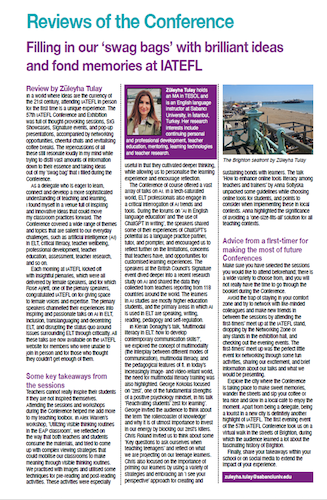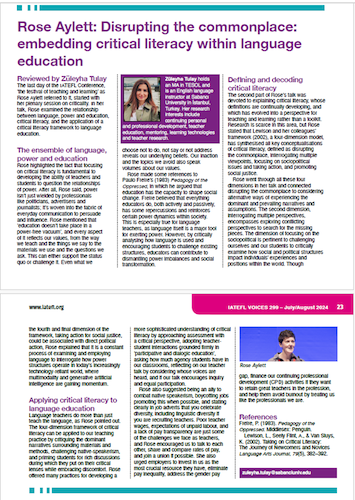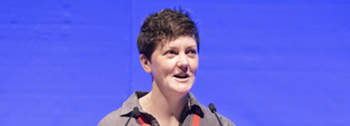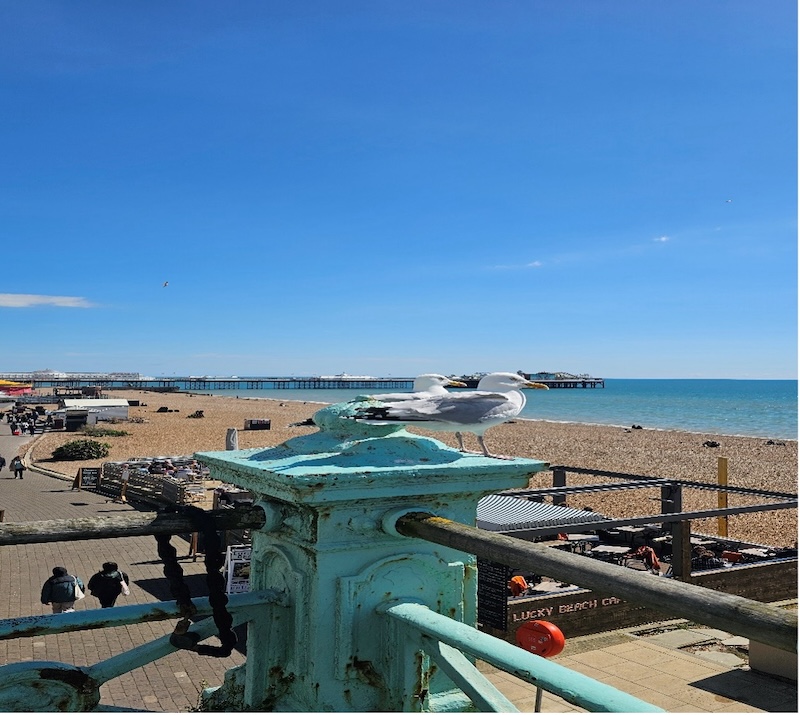Filling in our ‘swag bags’ with brilliant ideas and fond memories at IATEFL
Review by Züleyha Tulay
In a world where ideas are the currency of the 21st century, attending IATEFL in person for the first time is a unique experience. The 57th IATEFL Conference and Exhibition was full of thought-provoking sessions, SIG Showcases, Signature events, and pop-up presentations, accompanied by networking opportunities, cheerful chats, and revitalizing coffee breaks. The repercussions of all these still resonate loudly in my mind while trying to distill vast amounts of information down to its essence and taking ideas out of my ‘swag bag’ that I filled in during the Conference.
 As a delegate who is eager to learn, connect, and develop a more sophisticated understanding of teaching and learning, I found myself in a venue full of inspiring and innovative ideas that could move my classroom practices forward. The Conference covered a wide range of themes and topics that are salient to our everyday challenges, such as artificial intelligence (AI) in ELT, critical literacy, teacher-wellbeing, professional development, teacher education, assessment, teacher research, and so on.
As a delegate who is eager to learn, connect, and develop a more sophisticated understanding of teaching and learning, I found myself in a venue full of inspiring and innovative ideas that could move my classroom practices forward. The Conference covered a wide range of themes and topics that are salient to our everyday challenges, such as artificial intelligence (AI) in ELT, critical literacy, teacher-wellbeing, professional development, teacher education, assessment, teacher research, and so on.
Each morning at IATEFL kicked off with insightful plenaries, which were all delivered by female speakers, for which Rose Aylett, one of the plenary speakers, congratulated IATEFL on giving space to female voices and expertise. The plenary speakers channeled their experiences into inspiring and passionate talks on AI in ELT, inclusion, translanguaging and decentring ELT, and disrupting the status quo around issues surrounding ELT through criticality. All these talks are now available on the IATEFL website for members who were unable to join in person and for those who thought they couldn’t get enough of them.
Some key takeaways from the sessions
Teachers cannot really inspire their students if they are not inspired themselves. Attending the sessions and workshops during the Conference helped me add more to my teaching toolbox. In Alex Warren’s workshop titled ‘Utilizing visible thinking routines in the EAP classroom’, we reflected on the way both teachers and students consume the materials and tried to come up with complex viewing strategies that could mobilise our classrooms to make meaning through visible thinking routines. We practiced with images and utilised some techniques for pre-reading and post-reading activities. These activities were especially useful in that they cultivated deeper thinking while allowing us to personalise the learning experience and encourage reflection.
The Conference of course offered a vast array of talks on AI. In a tech-saturated world, ELT professionals also engage in a critical interrogation of AI trends and tools. During the forums on AI in English language education and the use of ChatGPT in writing, the speakers shared some of their experiences of ChatGPT's potential as a language practice partner, tutor, and prompting, and encouraged us to reflect further on the limitations, concerns that teachers have, and opportunities for customised learning experiences. The speakers at the British Council’s Signature event dived deeper into a recent research study on AI and shared the data they collected from teachers reporting from 118 countries around the world. The learners in AI studies are mostly higher education students, and the main areas in which AI is used in ELT are speaking, writing, reading, pedagogy and self-regulation.
 In Kieran Donaghy’s talk titled ‘Multimodal literacy in ELT: how to develop contemporary communication skills’, we explored the concept of multimodality (the interplay between different modes of communication), multimodal literacy, and the pedagogical features of it. In today’s increasingly image- and video-reliant world, the need for multimodal literacy training was also highlighted. George Kokolas focused on ‘zest’, one of the fundamental strengths of a positive psychology mindset, in his talk ‘reactivating students’ zest for learning’. George invited the audience to think about the term ‘the rollercoaster of knowledge’ and why it is of utmost importance to invest in our energy by blocking our zest’s killers. Chris Roland invited us to think about some ‘key questions to ask ourselves when teaching teenagers’ and reflect on what we are projecting on our teenage learners. Chris also focused on the importance of priming our learners by using a variety of strategies and embracing an ‘I see your perspective’ approach for creating and sustaining bonds with learners. The talk titled ‘how to enhance online tools literacy among teachers and trainers’ by Anna Soltyska unpacked some guidelines while choosing online tools for students and points to consider when implementing these in local contexts. Anna highlighted the significance of avoiding a ‘one-size-fits-all’ solution for all teaching contexts.
In Kieran Donaghy’s talk titled ‘Multimodal literacy in ELT: how to develop contemporary communication skills’, we explored the concept of multimodality (the interplay between different modes of communication), multimodal literacy, and the pedagogical features of it. In today’s increasingly image- and video-reliant world, the need for multimodal literacy training was also highlighted. George Kokolas focused on ‘zest’, one of the fundamental strengths of a positive psychology mindset, in his talk ‘reactivating students’ zest for learning’. George invited the audience to think about the term ‘the rollercoaster of knowledge’ and why it is of utmost importance to invest in our energy by blocking our zest’s killers. Chris Roland invited us to think about some ‘key questions to ask ourselves when teaching teenagers’ and reflect on what we are projecting on our teenage learners. Chris also focused on the importance of priming our learners by using a variety of strategies and embracing an ‘I see your perspective’ approach for creating and sustaining bonds with learners. The talk titled ‘how to enhance online tools literacy among teachers and trainers’ by Anna Soltyska unpacked some guidelines while choosing online tools for students and points to consider when implementing these in local contexts. Anna highlighted the significance of avoiding a ‘one-size-fits-all’ solution for all teaching contexts.
Advice from a first-timer for making the most of future Conferences
- Make sure you have selected the sessions you would like to attend beforehand; there is a great variety to choose from, and you won’t really have the time to go through the booklet during the Conference.
- Avoid the trap of staying in your comfort zone and try to network with like-minded colleagues and make new friends in between the sessions by attending either the first-timers’ meet up at the IATEFL stand, dropping by the Networking Zone or any stands in the exhibition hall, and checking out the evening events. The first-timers’ meet up was the perfect little event for networking through some fun activities, sharing our excitement and brief information about our talks and what we would be presenting. Explore the city where the Conference is taking place to make sweet memories, wander the streets, and sip your coffee or tea nice and slow in a local cafe to enjoy the moment. Apart from being a delegate, being a tourist in a new city is definitely another highlight of IATEFL. The first evening event of the 57th IATEFL Conference took us on a virtual walk in the streets of Brighton, during which the audience learned a lot about the fascinating history of Brighton.
- Finally, share your takeaways within your school or on social media to extend the impact of your experience.
Courtesy of IATEFL Voices Issue 299 July/August 2024
***
Rose Aylett: Disrupting the commonplace: embedding critical literacy within language education
Reviewed by Züleyha Tulay
The last day of the IATEFL Conference, ‘the festival of teaching and learning’ as Rose Aylett referred to it, started with her plenary session on criticality. In her talk, Rose examined the relationship between language, power and education, critical literacy, and the application of a critical literacy framework to language education.
The ensemble of language, power and education
Rose highlighted the fact that focusing on critical literacy is fundamental to developing the ability of teachers and students to question the relationships of power. After all, Rose said, power isn't just wielded by professionals like politicians, advertisers and journalists; it's woven into the fabric of everyday communication to persuade and influence. Rose mentioned that ‘education doesn’t take place in a power-free vacuum,’ and every aspect of it reflects our values, from the way we teach and the things we say to the materials we use and the questions we ask. This can either support the status quo or challenge it. Even what we choose not to do, not say, or not address reveals our underlying beliefs. Our inaction and the topics we avoid also speak volumes about our values.
Rose made some references to Paulo Freire’s (1983) Pedagogy of the Oppressed, in which he argued that education has the capacity to shape social change. Freire believed that everything educators do, both actively and passively, has some repercussions and reinforces certain power dynamics within society. This is especially true for language teachers, as language itself is a major tool for exerting power. However, by critically analyzing how language is used and encouraging students to challenge existing structures, educators can contribute to dismantling power imbalances and social transformation.
Defining and decoding critical literacy
 The second part of Rose’s talk was devoted to explaining critical literacy, whose definitions are continually developing and which has evolved into a perspective for teaching and learning rather than a toolkit. Research is scarce in this area, but Rose stated that Lewison and her colleagues’ framework (2002), a four-dimension model, has synthesised all key conceptualizations of critical literacy, defined as disrupting the commonplace, interrogating multiple viewpoints, focusing on socio-political issues and taking action, and promoting social justice.
The second part of Rose’s talk was devoted to explaining critical literacy, whose definitions are continually developing and which has evolved into a perspective for teaching and learning rather than a toolkit. Research is scarce in this area, but Rose stated that Lewison and her colleagues’ framework (2002), a four-dimension model, has synthesised all key conceptualizations of critical literacy, defined as disrupting the commonplace, interrogating multiple viewpoints, focusing on socio-political issues and taking action, and promoting social justice.
Rose went through all these four dimensions in her talk and connected disrupting the commonplace to considering alternative ways of experiencing the dominant and prevailing narratives and assumptions. The second dimension, interrogating multiple perspectives, encompasses exploring conflicting perspectives to search for the missing pieces. The dimension of focusing on the socio-political is pertinent to challenging ourselves and our students to critically examine how social and political structures impact individuals' experiences and positions within the world. Though the fourth and final dimension of the framework, taking action for social justice, could be associated with direct political action, Rose explained that it is a constant process of examining and employing language to interrogate how power structures operate in today’s increasingly technology-reliant world, where multimodality and generative AI are gaining momentum.
Applying critical literacy to language education
Language teachers do more than just teach the language as Rose pointed out. The four-dimension framework of critical literacy can be applied to our teaching practice by critiquing the dominant narratives surrounding materials and methods, challenging native-speakerism, and priming students for rich discussions during which they put on their critical lenses while embracing discomfort. Rose offered many practices for developing a more sophisticated understanding of critical literacy by approaching assessment with a critical perspective, adopting teacher-student interactions grounded firmly in ‘participative and dialogic education’, asking how much agency students have in our classrooms, reflecting on our teacher talk by considering whose voices are heard, and if our talk encourages inquiry and equal participation.
Rose also suggested being an ally to combat native speakerism, boycotting jobs, promoting this when possible, and stating clearly in job adverts that you celebrate diversity, including linguistic diversity if you are recruiting teachers. Poor teacher wages, expectations of unpaid labor, and a lack of pay transparency are just some of the challenges we face as teachers, and Rose encouraged us to talk to each other, share and compare rates of pay, and join a union if possible. She also urged employers to invest in us as the most crucial resource they have, eliminate pay inequality, address the gender pay gap, finance our continuous professional development (CPD) activities if they want to retain great teachers in the profession, and help them avoid burnout by treating us like the professionals we are.
References
Freire, P. (1983). Pedagogy of the Oppressed. Middlesex: Penguin.
Lewison, L., Seely Flint, A., and Van Sluys, K. (2002). Taking on Critical Literacy: The Journey of Newcomers and Novices. Language Arts Journal, 79:5, 382-392.
Courtesy of IATEFL Voices Issue 299 July/August 2024
***
Photograph: The Brighton Seafront by Züleyha Tulay
zuleyha.tulay AT sabanciuniv.edu

